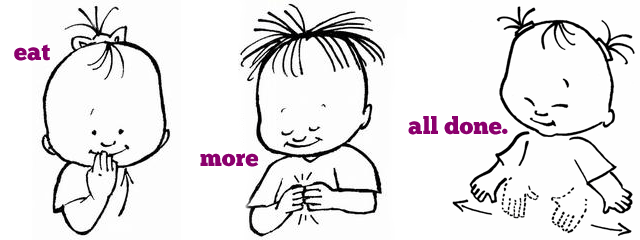Blog
How to use sign language to foster your child’s Speech and Language development

Did you know that sign language can be beneficial to not only individuals with hearing impairments, but also to babies who are first learning to communicate? In fact, babies actually develop the ability to point and gesture before they even use words to express their wants and needs! Many parents may be skeptical to introduce sign language to their babies out of fear that it may actually delay the development of spoken language. However, research as shown that sign language often provides a bridge to support a child’s spoken language development.
So what exactly are some of these benefits to using sign language?
- Sign language can reduce frustration by providing children a way to express their wants and needs. Research has shown that having an alternate way to communicate often decreases behavior issues, such as screaming and crying, because the child can more effectively communicate their wants and needs
- Sign Language can improve language, vocabulary and reading skills. When a child hears a word paired with a visual sign, the child is actually receiving two repetitions of the word through two different modalities. These repetitions can actually strengthen a child’s ability to recall and and enhance the development of oral language for reading comprehension. “The benefit of using this system is the representation of information through seeing, hearing, and movement. The more pathways created in the brain, the stronger the memory.”
- Sign language can also help children to expand the length of their utterances. Studies have shown that when children are exposed to sign language, they have a better understanding of the grammatical structure of English, and use language in a more productive manner. If a child is only using one word utterances to communicate wants and needs, such as milk, parents can model that word and pair it with a sign, for example “more milk.
Now that you know about some of the benefits to using sign language with your child, your probably wondering, how do I choose which words to introduce first? When choosing words to target, you need to keep in mind what is going to be the most functional and beneficial for your child, in order to help them effecitvely communicate in a wide variety of situations. Some common early signs include:
- More
- eat
- drink
- play
- stop
- finished/ all done
- help
- my/mine
Remember that all children are different and some may require more assistance than others, such as hand-over-hand assistance, in order to use sign language to communicate. If you are considering introducing sign language to your child, consult with a speech language pathologist for tips on how to appropriately teach and chose sign language targets that are individualized to meet the needs of your specific child
Resources:
Vroom, J. (2004) Encouraging Spoken Language through Signs. Super Duper Publications.
Shari Robertson, Ph.D., CCC-SLP ASHA Convention, 2007 USING SIGN TO FACILIATE ORAL LANGUAGE: BUILDING A CASE WITH PARENTS
Melanie Yovino M.A CF-SLP




